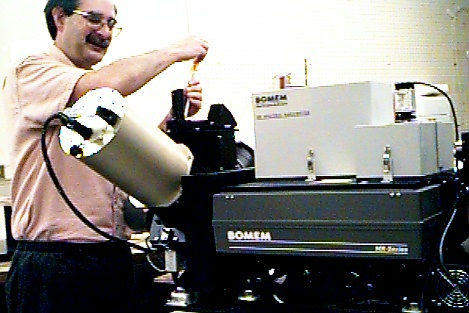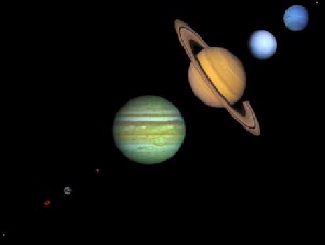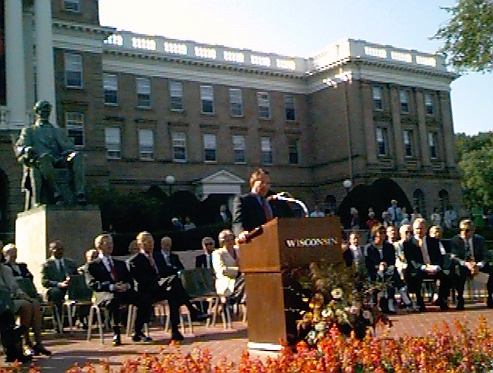Monthly News Summary – October 1998
A Swirl of Hurricanes
by Terri Gregory, SSEC Public Information Coordinator
A report on current SSEC news and other events. This column covers news events from mid-August through mid- September 1998.
October 1998
Researchers from throughout the United States participated in the Convection And Moisture EXperiment-3 this August and September to study hurricanes. The researchers were based in Florida, primarily at Patrick AFB, and on the Bahamas’ Andros Island. The weather cooperated, giving them Hurricanes Bonnie, Danielle, Earl, and Frances. The field phase of CAMEX-3 ended on September 23, but was extended to take advantage of Hurricane Georges, which may prove to be the most damaging of the season’s storms, if not the most productive for researchers.
SSEC and CIMSS participated with the Atmospheric Emitted Radiance Interferometer (AERI) on the ground in the Bahamas. As the hurricane season heated up, the media descended on SSEC participants in the field, and also covered research of CIMSS’ Tropical Cyclones team back at UW-Madison. Ron Seely started the local media barrage with a CAMEX-3 summary in his Thursday column on August 13 in the Wisconsin State Journal. He said, “results from the experiment may increase warning time and help forecasters decrease the size of evacuation areas.” Seely later interviewed Wayne Feltz for an August 27 article, after Wayne hitched a ride on NASA’s DC-8 as it flew through Hurricane Bonnie. Wayne, a researcher on SSEC’s AERI team, took spectacular pictures of the hurricane’s eye wall and other clouds, and gave a personal angle to the experiment’s story.
The Capital Times used the Associated Press version of Ron’s piece on Friday, August 28. TheIsthmus, Madison, Wisconsin’s weekly newspaper, also featured CAMEX-3, Wayne’s hurricane adventure, and Chris Velden’s comments on his own hurricane experience in a piece by David Medaris on September 4. Wisconsin researchers were interviewed for a Discovery Channel program, which aired first on August 28. WOLX Radio interviewed Wayne Feltz, capitalizing on his hurricane flight. The Milwaukee Journal Sentinel included information on SSEC involvement in a longer article on the whole experiment. Bob Knuteson, who led the efforts of the AERI researchers, stated that he hopes for satellite versions of some of the instruments used in CAMEX-3, “to improve prediction of when hurricanes reach land.”
For more information, follow the links below.
SSEC was responsible for its AERI instrument (on the ground in the Bahamas) and for the Scanning-HIS (a new version of the High-resolution Interferometer Sounder, which flew on NASA’s DC-8 in its first mission from September 13 through the experiment’s end). SSEC’s AERI crew also set up a special group of instruments to measure surface and other conditions, including a Global Positioning System to measure water vapor. The data from this unique grouping will be used not only to verify measurements from the AERI but to verify other experiment data.
 |
AERI program manager Fred Best adjusts the instrument before sending it into the field. |
SSEC also provided support for NASA’s Langley Research Center’s NAST-I instrument, including Web pages for quicklook data and the Tropical Cyclone group’s wind images. NAST-I stands for NPOESS Aircraft Sounder Testbed-Interferometer, with NPOESS meaning Next Polar Orbiting Environmental Satellite System. SSEC’s NAST involvement was featured on the Discovery Channel in a program on CAMEX-3.
Wayne Feltz and Tom Whittaker both prepared Web pages for the official CAMEX Home Page. Tom’s features a nifty new Java applet enabling instant viewing of a combined choice of data, instruments and times.
Brian Mattmiller, University of Wisconsin-Madison News and Public Affairs science writer, drew attention to ongoing hurricane research here in SSEC. Thanks to his release, Madison’s WISC TV3 and WKOW interviewed Chris Velden, who told television viewers about the CIMSS Tropical Cyclone group’s current research on August 27 and 28.
NBC-TV used SSEC’s enhanced images of Hurricane Bonnie, showing it bearing down on the U.S. east coast. USA Today used an enhanced image on the front page of its newspaper on Monday, August 24, and posted it on its Web page on Sunday, August 23. Chris Velden, leader of the CIMSS team, said that increased network use of our imagery may be because the Tropical Prediction Center (formerly National Hurricane Center) mirrors our site when hurrincanes threaten the U.S. because of increased Web traffic. Mirroring TPC’s Web site undoubtedly caused the Tropical Cyclones Web site hits to increase stratospherically, and to account for 85% of CIMSS Web traffic in the week ending August 21. Individual visits to the Tropical Cylcone page during August topped 1.9 million! (The ASCII text file of statistics was 200 MB big.)
The Why? Files, published by University News and Public Affairs (UW-Madison), used a color enhanced image of Hurricane Bonnie in its Cool Images page for the week of August 27. The GOES-8 image shows Bonnie dramatically threatening the U.S. southeastern coast, aiming at the Carolinas.
Tropical Prediction Center Forecast Positions
Joint Typhoon Warning Center Forecast Positions
During this hurricane season, a variety of uses are being made of the Tropical Cyclones group’s research. Houston’s Emergency Managers Weather Information Network regularly inserts the colored infrared images into their data stream. Ed Matthews, meteorologist at WFMY-TV 2 (CBS) in Greensboro, North Carolina uses the images in his forecasts. Chris Velden helped direct sonde drops during an aircraft mission into Tropical Storm Bonnie; the measurements in key areas of thin cirrus and low clouds were used to validate wind vector height assignments. Regular, and arguably most important, users are the U.S. Navy’s Joint Typhoon Warning Center and the National Weather Service’s Tropical Prediction Center. Wind measurements are sent in real time, even before the images are posted on the Web. Forecasters find the winds to be particularly useful in a case like that of Hurricane Bonnie, where the steering pattern was not straightforward. Depending on data used, Bonnie could have either bypassed the U.S. coast altogether or come ashore. The CIMSS “water vapor winds” enabled a correct forecast—the hurricane did hit the coast after stalling.
Watch the November 1 issue of In the News for more hurricane coverage.
Outreach
Planetary Scientists in Conjunction
For More Information
More than 600 scientists from around the world are expected to attend October’s Division of Planetary Science meeting to be held October 11–16 at Madison’s Monona Terrace Convention Center. Terry Devitt’s release to the media appears concurrently in online and print versions of the campus newspaper, Wisconsin Week, and has gone out to the world. According to Sanjay Limaye, SSEC planetary scientist who is coordinating the meeting, the event was last held in the Midwest 20 years ago, in St. Louis.
 |
This artist’s conception shows all nine planets, roughly to scale and in their correct order from the sun. In reality, they never align like this; their orbits vary too much. Can you name all nine? You’ll find the answer at Nine Planets. |
Madison’s Capital Times reporter Gwen Carleton noted September 28, that “as part of NASA’s growing emphasis on sharing its work with the public, the meeting …will include numerous events designed especially for visitors.” An exhibition celebrating decades of solar system exploration will include spacecraft models, a Mars meteorite fragment, and exhibits from NASA, NOAA, the Adler Planetarium, the Jet Propulsion Laboratory and others. The exhibit will be open to the public from 4 to 8 p.m. on October 11; from 5 to 8 p.m. October 12, 13 and 15; from 3:30 to 6 p.m. October 14; and from 9 a.m. to noon October 16. A stargazing party will be held in the Monona Terrace rooftop Evjue Garden Thursday evening at 7.
Festive Weather Forecast
Scott Bachmeier, CIMSS researcher, forecast the weather for the Wisconsin Folklife Festival August 20–23 held in downtown Madison. Organizer Ann Pryor of the Wisconsin Arts Board said that volunteers appreciated his services. Ann said, “he said it would only rain lightly and it did!” Scott correctly forecast Thursday’s gentle two-hour rain that barely disrupted festivities. Volunteers were ready at a half hour’s notice to close up shop if necessary. Scott and the Festival were lucky. Most of the rain Scott forecast either was gentle or fell towards the end of the day or in the very early morning.
Outreach
Precise Sea Surface Temperatures
For More Information
UW Participates in Miami Workshop
Accurate measurements of sea surface temperature (SST) are extremely important in the study of global change. The Moderate-Resolution Imaging Spectroradiometer (MODIS), scheduled to fly on satellites in the Earth Observing System, will measure the SST very accurately. SSEC’s M-AERI (Marine-Atmosphere Emitted Radiance Interferometer) and other radiometers are being used for validation studies being made before satellites launch. Bob Knuteson, scientist on SSEC’s M-AERI team, likens it to a “consistency check on our calibration procedures.” While prohibitively expensive for widespread use, the M-AERI is very accurate, the most accurate of the radiometers presented at workshops held at the Rosenstiel School of Marine and Atmospheric Science March 2-6, 1998 in Miami. The Rosenstiel School and UW-Madison lead the effort to use sea surface temperature measurements from ship-based radiometers to validate those expected from satellites.The Earth Observer, May/June, reviewed the workshops.
Smoke over Stratus
To illustrate an article on May weather, the September/October issue of Weatherwise features Scott Bachmeier’s picture of smoke over stratus clouds. In the GOES Gallery, Scott said, “Several large fires were burning out of control across the Canadian province of Alberta during the first week of May 1998. Thick smoke drifted southward across the U.S./Canada border during 05 May and 06 May, and was eventually entrained into the circulation of a cyclone which was migrating southward across North Dakota on 07 May. Air mass trajectories from the NOAA Air Resources Lab suggest that the flow arriving at three points along the smoke filament … originated over or near Alberta 2–3 days earlier.”
UCAR Highlights VisAD
VisAD, a system created by SSEC’s Visualization Project, is featured in Highlights, a report for 1998/1999 from the University Corporation for Atmospheric Research. According to the report, Java VisAD “establishes the foundation for manipulating and viewing many types of numerical data.” SSEC’s Bill Hibbard, project leader, is quoted on system benefits: “People all over the Internet can pop up the same interface and work together as if they were on the same workstation.” The University of Wisconsin–Madison is a member of UCAR.
Suomi Scholars Cited
Wisconsin Week, August 26, listed the first CIMSS Suomi scholars, including Jason Brunner, who graduated from Monona Grove High School this spring. Jason has worked as a student hourly employee this summer for CIMSS building Web pages and learning McIDAS; he is beginning full-time study as a freshman in the Department of Atmospheric and Oceanic Sciences. The other scholars are Ryan Torn, Menominee Falls North; Moire Prescott, Madison Memorial; and Lance Wamsley, Cassville, all in Wisconsin.
Radiometer Work Noted
The University of Wisconsin Foundation’s annual report for 1997 notes honors given to university achievers. Top among them is Larry Sromovsky’s award from NASA, honoring his leadership of the Galileo Probe’s Net Flux Radiometer team. Larry, a senior scientist at SSEC, received the Exceptional Scientific Achievement Medal.
NASA’s Jet Propulsion Laboratory has issued its 100th Voyager Bulletin, summarizing mission accomplishments. Professor Verner Suomi, SSEC’s founding director, served on the Voyager Imaging Science Team and SSEC scientists analyzed imagery from all four planetary encounters on SSEC’s Man computer Interactive Data Access System. Through SSEC research, the University of Wisconsin–Madison became one of very few universities where Voyager data is studied to learn more about planetary atmospheres. From the launch of Voyager 1 in 1977, the Voyagers investigated the four giant planets—Jupiter, Saturn, Uranus, and Neptune—for twelve years. As they travel to the farthest reaches of our solar system, the Voyagers continue to return data on the solar wind.
Sesquicentennial Events
SSEC Noted in 150 Years’ Celebration
For More Information
The University of Wisconsin-Madison is celebrating its 150th birthday this year, and SSEC is among the participants. At the Proclamation Ceremony on Bascom Hill opening the year’s festivities on September 10, Governor Thompson listed many university notables, including Noble Laureate Howard Temin. To top off his list, he said, “and the Space Science and Engineering Center extends the boundaries of the University [into space].” The governor followed three university leaders.
 |
Governor Tommy Thompson delivers at the Sesquicentennial Proclamation Ceremony. |
Chancellor David Ward spoke on the university’s tradition of excellence. System President Katharine Lyall noted that 1848, the year the university was founded, was a year of political revolt and economic turmoil around the world and in the United States. The university founders, she said, “did not wait till things settled down,” but pushed forward with their plans. Regents President San Orr spoke of this century becoming one of biotechnological discoveries, with the university at the cutting edge. SSEC can be pleased to be included in those who keep the university there.
The work of SSEC Founding Director Verner E. Suomi is noted in a three-dimensional Sesquicentennial display. Professor Suomi is shown with an early weather satellite that bears his experiment. Many important university people and events are shown in the colorful traveling exhibit, currently touring the state.
Chancellor David Ward’s 1997-98 Annual Report for the University of Wisconsin-Madison honors the university’s 150th year. Its “150 Ways” details ways that the “University of Wisconsin-Madison has touched the world.” That may seem like many, but the section covers 150 years. SSEC is included twice, although we were established recently, in 1965. Professor Suomi’s satellite work is covered. So are our spaceflight hardware and data collecting activities, with a picture of Neptune from Larry Sromovsky’s Space Telescope observations.
On the Air
For More Information
NBC evening news used SSEC’s global montage to show cloud cover over Afghanistan on the day U.S. bombed suspected terrorist camps. The bombing took place Friday morning, August 24; the story ran that evening.
Watch for Earth’s Fury, a Learning Channel program, which may run this fall. GOES data from SSEC is used to illustrate severe weather.
Bob Aune, CIMSS researcher, appeared on Kathleen Dunn’s Friday afternoon call-in show on Wisconsin Public Radio on August 7, answering questions about “the crazy weather we’re having.” In early August, some of Wisconsin was blistering under an unrelenting heat wave while some of the state was in danger of floating away in heavy rains.
The Weather Guys, SSEC’s Steve Ackerman and AOS’ Jon Martin, appeared a second time on Larry Meiller’s morning call-in show on Wisconsin Public Radio. Their second success, with even harder questions from Larry’s listeners, occurred on August 26.
On the ‘Net
Interesting Connections
For More Information
Academic Guide to the Internet
The UniGuide Academic Guide to the Internet, formerly the InterNIC Academic Guide to the Internet, lists the CIMSS Web site in its list of Geosciences resources. The Guide lists many Web resources of possible interest to academic researchers in many fields of study.
For a second time, SSEC provided McIDAS data for Steve Fossett’s attempt to fly around the world in a hot air balloon. Steve ended his flight early in the South Pacific, but you can find flight information at Mission Control, provided by Washington University in St. Louis. Click on maps to see the data SSEC provided.
SSEC’s volcano page is included in a Web site offering earthquake, tsunami and volcano information.
Catch pictures of the deployment of SSEC’s heat-sensing ocean buoy on Gettin’ There, Web site of Joe Fetro. Joe captains Gettin’ There II, a charter boat mostly used for fishing, but available for occasional high-tech purposes. The pictures show the buoy being deployed off Florida’s Atlantic coast.
